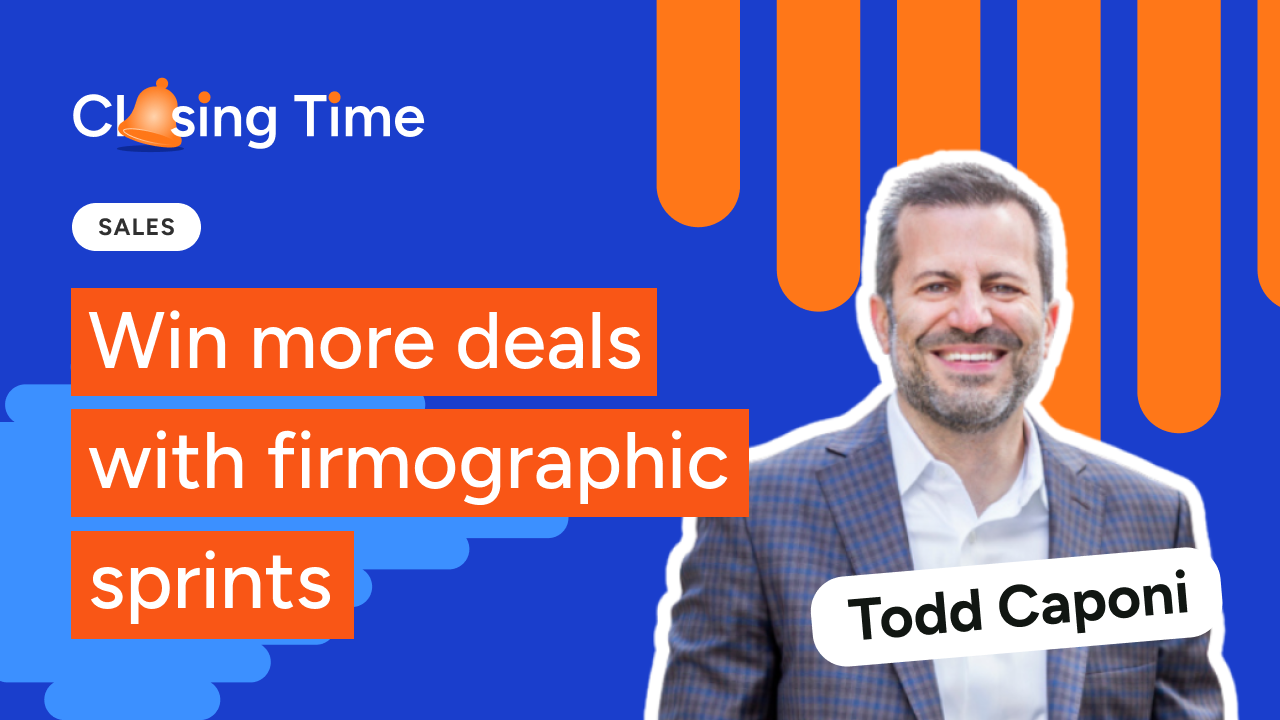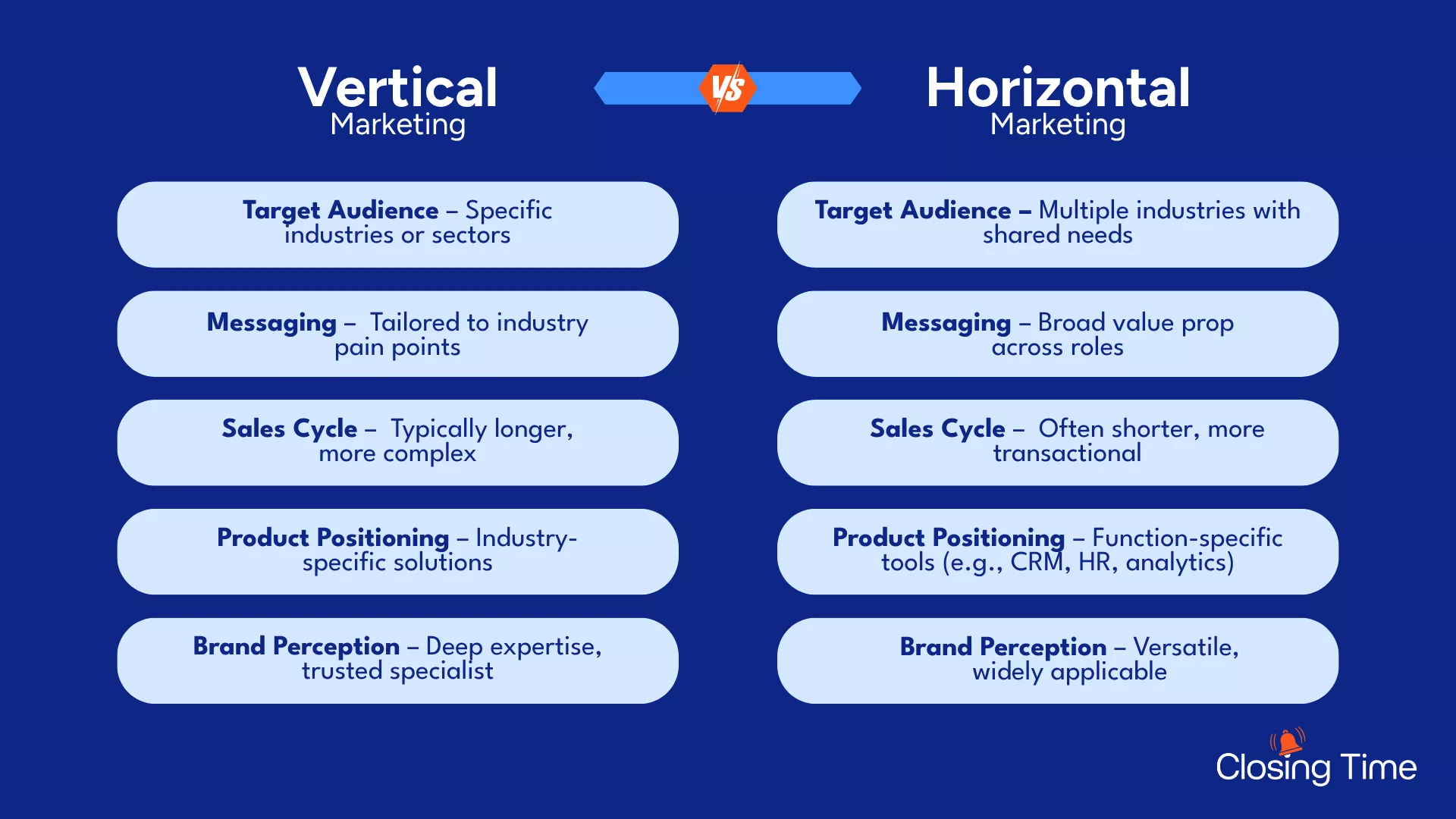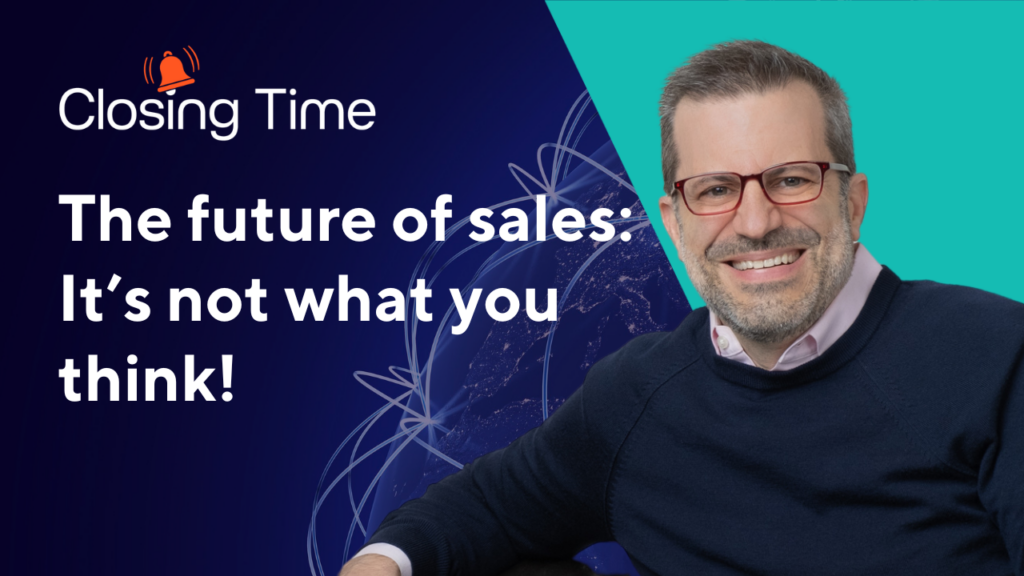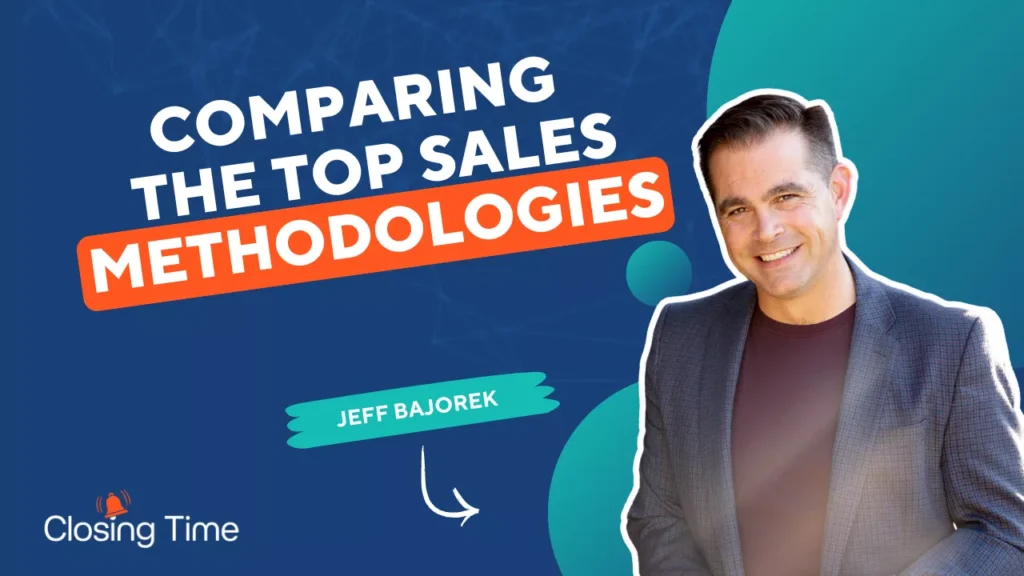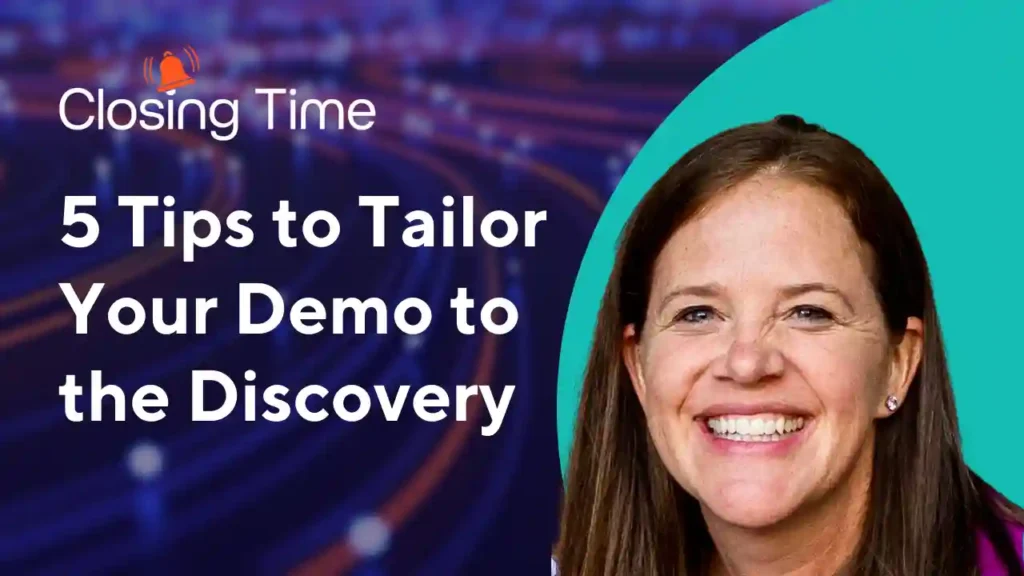What are firmographic sprints and how should you be using them?
Let’s talk all about it on today’s episode of Closing Time.
Thanks for tuning into Closing Time, the show for go to market Leaders.
I’m Val Riley, head of marketing for Unbounce, Insightly, and LeadsRx.
Today I’m joined by Todd Caponi.
He is a sales consultant and author of The Transparency Sale,
The Transparent Sales Leader, and soon to come Four Levers Negotiating.
Todd, welcome to the show.
Thanks for having me. Great to see you.
Yeah.
So, fun fact
you were actually the very first guest on Closing Time more than two years ago.
Since then, we’ve aired 160 episodes and had well over 100 guests.
But you were there when it all began, and Todd.
That’s right.
That’s a tear rolling down my cheek with joy. So.
So we wanted to reconnect with you because you did a training session
for our sales team here at Insightly and Unbounce and,
you know, we focused a little bit on verticals and,
you know, we looking at our business in this way,
you know, perhaps we thought maybe other people,
other businesses were struggling with the vertical conversation.
So it felt like a good opportunity to bring you in.
Perfect.
Yeah.
I think, you know, to start, when we talk about verticals,
I, at its core, have always felt like
so many good and well-run organizations.
They defined what’s called their ICP, their ideal customer profile.
Right.
Which is cool. Yeah, we should do that.
However, I’m actually an advocate for doing something called
firmographic sprints within the ICPs.
I call them extreme firmographic focus sprints,
and we can talk a little bit about what that means and how that works.
But it has had a marked impact on my career as a leader.
The organizations that I’ve run, and they’re actually not that hard to execute.
All right.. So you’ve got my interest piqued.
What how do you define a firmographic sprint
and how should businesses be using them?
Well, I’ll start with a little story.
So way back when, when I took on my first SVP sales job,
I it was a small team
and we had a massive addressable market.
Our ICP was huge.
It was anybody that was in discrete manufacturing.
So for anybody that doesn’t know what that means,
discrete manufacturing is essentially any organization
that builds stuff
where they start with pieces, they put it together to make something big.
So that’s airplanes, cars, heavy machinery, oil rigs,
all that kind of stuff.
So imagine you got six reps,
you got a thousand potential customers you could call them.
Cool, like that’s our ICP discrete manufacturers.
Here’s the problem.
When my reps would wake up in the morning,
they were essentially focused on multiple verticals,
multiple buyer personas across multiple geographies every single day.
And as a result, if you’re calling on five verticals in a day, ten verticals
in a day, you can only truly be an expert in what you do now and what they do.
And so what had happened was we were struggling
as an organization, but we’d realized aerospace and defense.
Gosh, you know what?
That could be a really good spot for us.
There’s plenty to go after for six reps.
Our deal sizes are really big.
We’re winning a high percentage of them and we’re winning them fast.
Let’s double down there.
And so we ended up my CEO knew, a retired aerospace
and defense expert, a guy that had been in the industry for 40 years.
He was retired.
And he’s like, hey, I betcha he’d come in and hang out with us for a little while.
So we brought him in.
We have him teach our reps,
and I’m going to go through the four core categories of information.
You need to be able to execute this in a minute.
But we had him just start to teach us about aerospace.
and defense.
Next thing you know, my reps that have 200 accounts each to go after,
we didn’t have to shrink their territories.
They’d wake up in the morning and go, who are my aerospace and defense ones?
I can’t wait to call them.
And they started doing that.
All of a sudden we went.
We were only doing 3 million in revenue at the time.
We did a $7 million deal with Boeing.
We then got Northrop Grumman.
We got Gulfstream, we got Cessna, and the next thing you know,
we’re growing 400% year over year.
And then we started to go out slowly from there.
And started to do that with other industries.
But the point being that once we got all of our reps to be really, really smart
about aerospace and defense, their confidence became contagious.
Those customers welcomed us in because we were making them smarter
about their business, not ours, and they couldn’t wait to invest in us
because they saw us as partners and not vendors.
That, at its core, a firmographic sprint
was focusing on one tight swim lane, 4 to 8 weeks.
Dive deep into it, and then you start to see the fruits of that
and then move out slowly from there.
That’s all the concept is.
Todd, is this specifically for the outbound, efforts
that the sales team is doing, or did you coordinate with the marketing team
to have inbound leads coming in for that specific firmographic type?
Well, yeah, it was definitely collaborative.
So marketing was highly involved in this and the marketing’s lens on this.
So here’s the the other piece that always kind of drove me nuts.
We look at this funnel concept and like
hey let’s bring everybody in and then we’ll vet them and go through.
And the good stuff will come out the bottom.
I’ve always been an arguer that every lead has a cost,
you know, whether it’s a cost of us having to spend our time and engage in it,
whether it’s we engage with it, we find they’re not a good fit.
But now they look at us as not a good fit.
And the next thing you know, they’re telling their friends, oh, don’t go there.
They don’t like things.
They’re not they’re not a good fit.
And so what I was always trying to create
is instead of a funnel, create a cylinder
where our marketing efforts were focused on, hey, let’s do some
explosive type stuff around aerospace and defense for a while.
Let’s aligned to the events that are going on in that space.
And when I take you through these four things here in a minute,
you’ll see how that all feeds itself,
that we become the experts in that space and the go to.
And then when any aerospace and defense company is thinking
about a solution like ours, we’re the first ones they call that.
That’s really the goal of all of that alignment, is just on brand.
Let’s brand ourselves
as the experts in this space, even though we can call on all these.
This is our bread and butter right now.
And then you expand out slowly from there.
So at the time you’re in that firmographic sprint
specifically for aerospace inbound leads that are coming in, for other industries,
you’re still working those leads effectively as well,
but it’s just not the the focus at that time.
Exactly, exactly.
It’s meant to be a confidence builder and to really hone
our focus and become experts in a space for short sprints.
It does not mean that we need to shut off everybody else.
If somebody wants to buy from us and we know again,
we know we can help them achieve optimal outcomes, right?
As one of the quotes back here from 1921
says, if the truth won’t sell it, don’t sell it.
So just because it’s inbound doesn’t mean you have to sell to them.
However,
just because you’re doing a firmographic sprint doesn’t mean you shouldn’t sell
to them either.
And just one more in the weeds question.
How long would one of these firmographic sprints typically last?
Well, it really all depends on how big the deals are that you’re working,
and kind of the comprehensive nature
of the consensus buying environment that you’re selling to.
I, one of the companies that I advised,
they were selling more transactional stuff.
They did just a little six week sprint around,
but they were selling the retailers and brands.
They did a little six week sprint around apparel, footwear
and started just learning everything about the shoe space.
The next thing you know, they got Crocs, they got Skechers, they got ecco,
and they’re like,. Holy crap, let’s go to health and beauty.
And they just kind of went out slowly from there.
They could do it faster in our world, in aerospace and defense.
We did it for a longer period of time because these are heavily invested deals.
I only had six reps and suddenly we had a pipeline
of seven figure deals that we all needed to be focused on.
So that one obviously took a little bit longer. Todd.
What does it take to do a focused firmographic sprint?
Well, one of the things that’s funny to me is, you know, a lot of times
when I talk to companies,
they’re bringing customers in, they’re bringing experts in.
And a lot of times when they bring customers
in, they’re always asking them, hey, tell us about how awesome we are.
Oh, what problems did you have that we could solve, like that
kind of stuff, which makes you feel good, but it doesn’t really help you.
My process
on this is whenever we’re engaging with customers or experts.
There’s four core categories of things that we want to learn
that are going to help us be smarter so that we can help our customers be smarter.
The number one thing.
So we brought that expert and
and when we even talk to any experts, we talk to customers
or we talk to experts within our own company, which I’ll get to in a second.
Question number one, that we always ask them was,
what are the current headwinds and tailwinds
going on in your industry in your role right now?
So what’s keeping you from accomplishing your goals?
And what are the things that are swooping you up and making you feel really good
about what’s to come?
Understanding those headwinds and tailwinds was vitally important.
So that was number one.
Number two is understanding how they’re measured.
So thinking about we are selling two heads of manufacturing for example.
But what constitutes success in your role.
But what are the key things whether they’re metrics or milestones
that determine whether or not you’re succeeding in your role or not?
Really important to know,
especially if you’re going to be calling on VP of manufacturing, for example.
Number three is
where do you go to get smarter about your industry and your role?
In other words, what are you reading?
Who do you follow or the podcast that you listen to?
And we would get those answers and then we would go start following them.
We would start being there. Right?
So that one was super important and super valuable.
And then number four, which isn’t really a question, but it’s so helpful.
I can’t believe more people don’t do this is show us your inbox.
In other words, would you be willing to show us in your inbox
what kinds of messages you get from people like us,
and what are the ones that automatically get deleted,
and which are the ones that you want to read and dig into?
And once you do, which are the ones that go, oh,
this person’s helpful versus this person’s trying to sell me.
So show us your inbox was always a fun one that we’d always ask.
We’d always tee it up ahead of time so they wouldn’t be put on the spot.
But along those same lines,
we would ask that of executives in our company
all the time, whether they have anything to do
with our role that we’re trying to sell into or not.
Back in one of my companies, you know them.
It was exact target we were selling to marketers
right down the hallways or CMO, bring them into a sales meeting and go,
hey, Tim, show us your inbox.
Like what’s standing out?. What’s getting deleted?
Hey, digital marketing team, come on.
What do you get?
Right?
That empathy for the inbox of an executive,
for people that are going to contribute to the deals that you’re working on,
especially your customers and the experts
in the space, the most valuable thing that we could have ever done.
And we did it over and over and over it again.
So number four, show us your inbox.
Love it. Todd.
So I feel like when the sales person is educated,
the expectations of the sales process are going to change.
Like when the prospect knows that this vendor understands their business.
I feel like there’s a shift
in their expectations for how that buyer’s journey is going to go.
Yeah, I think so.
One of the core things that we did is, again,
this might sound crazy, but. I always viewed the way that you engage
with customers should be more like that done on reality makeover TV shows.
I know that might sound crazy, but if you ever watch The Queer Eye,
a restaurant, a possible Biggest Loser,. Extreme Makeover Bar Rescue,
they always follow an approach that does never involves
a bunch of slides at the beginning talking about here’s our products
and our awards and our mascots, like that would be the boring a show of all time.
What do they always do?
Well, they walk in and they align first like, hey,
why would you even take a call with me?
Right?
You’ve got a billion things going on, I know it,
but you’re spending an hour with me. Why?
Tell me about. All right, cool.
Hey, from our understanding of your role in your industry,
here’s some things that I’m guessing are top to mind.
The top of mind that you didn’t mention.. What about this?
What about this?
And you all of a sudden
start to get that momentum, that, oh, wow, this person is a peer of mine.
And as a result,. I’m more willing to listen.
Now, one of the things that was really important
when we did that giant deal with Boeing way back in, like 2008, 2009,
they had a problem that they needed solved.
But through that understanding of the headwinds and tailwinds, Boeing,
for example, at the time, they were trying to get 787 out the door
and having a real hard time, and they’re getting roasted on CNBC.
My rep, who’s now retired.
But he went in there with a conversation around, hey, here’s the problem.
Here’s the potential solution.
But gosh, can’t we tie that to potentially speeding
these planes out the door and doing it at a lower cost and really starting to,
you know, get some smoke going around that idea of a real business issue
that is creating risk in the business, causing revenue to slow,
it’s increasing costs.
We could solve all that.
And what could have been perceived
as a $200,000 solution turned into a $7 million solution.
So again, that expertise not only helped us become smarter and gain an audience,
but that expertise also caused our deal sizes to grow dramatically.
One other point to make, Val, is,. I remember we had had these meetings.
This was actually a
few years later when I was the CRO of power reviews.
We started doing this.
I remember walking into a board meeting
and my board looked at our qualified opportunities
and our pipeline, and we had just had a really good quarter.
They looked at that and they were like, Todd,
the number of qualified opportunities is down.
What’s going on?
Like, what are we in trouble six months from now?
What what’s marketing not doing?
And I was like, I love it, I love it.
My marketing is doing exactly what I want them to do.
And the fact that it’s down is exactly what I want.
Because we always again, go back to this idea
that more leads, more opportunities, leads to more revenue.
I believe that better opportunities, those smaller number of more tightly
aligned opportunities that close at a higher dollar amount,
that close more often, that close faster, is the key to getting the kind of growth
that you want.
It requires a mind shift.
But these extreme
firmographic focus sprints were core to making all of that happen.
And when we became Chicago’s fastest growing tech company from 2014 to 2017,
and I swear some of those types of things
were big contributors to making that happen.
I you can’t argue with success.
So I guess the big question is
if I wanted to move forward with firmographic sprints,
how do you select which verticals you want to focus on?
Do you look at historical wins and work backwards,
or is it more forward looking or what’s going on in the market?
How do you advise companies on what what lanes to start to swim in?
Yeah, I mean, I guess the answer is yes to all of those, really
looking at recent wins and then tying
those recent wins across how big are they?
How often are we winning them and how quickly,
like, do we have a message that’s really resonating in that space.
So that requires looking at your wins.
I’m also such an advocate for not only looking at the losses.
I’ve always advocated for this concept of celebrating the losses.
Meaning when you lose a deal,
it’s not a hey, better luck next time.
Go get em, champ.
It’s hey, let’s celebrate you for the effort.
Let’s
even higher celebrate you for the lessons that can be learned.
And the more you’re willing to point out the things that maybe you wish
you would have seen earlier or have done different something
going on in the space that’s going to help everybody with deals like that,
look at their deals and go, am I investing my most valuable asset,
which is my time in the right opportunities here that helped illuminate
so often where those firmographic focus sprints should happen
and where they shouldn’t, which is even more important.
All right.
Great advice, Todd.
As always, thank you so much for coming back on the show.
We do appreciate seeing you.
And I think we’re all going to go off and focus on our first firmographic sprint.
There you go. Thank you.
And thanks to all of you for tuning in to Closing Time.
Remember, you can get the show delivered right to your inbox.
Just click the link in the show notes. We’ll see you next time.

